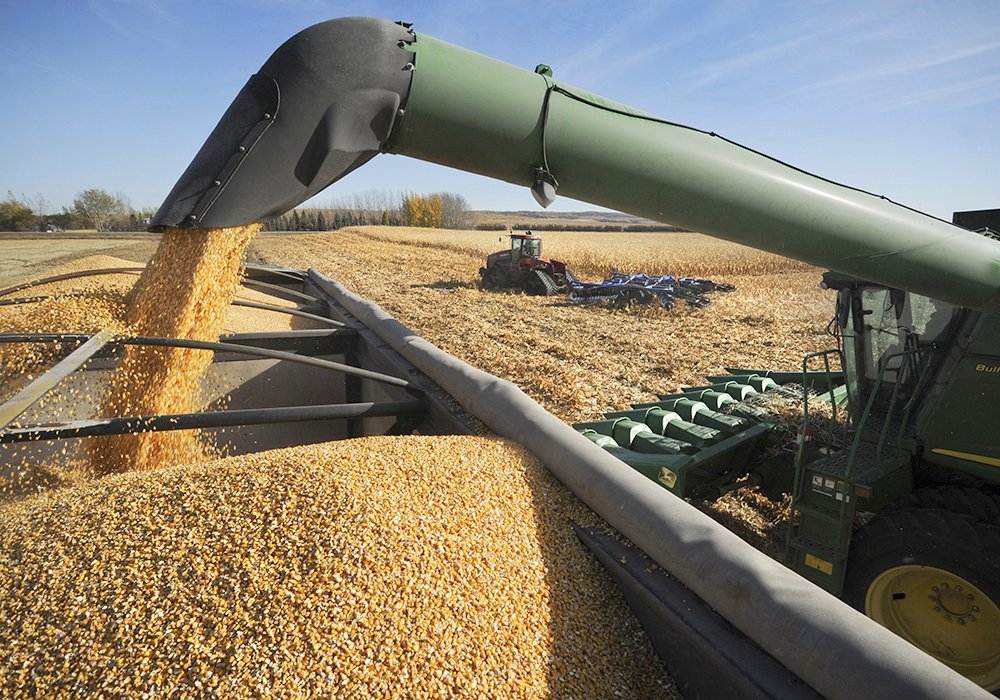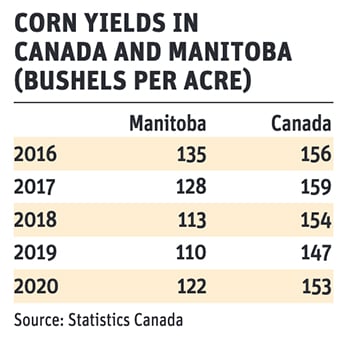Record corn prices expected to offset disappointing yields

Production has been all over the map in Manitoba this year, but local demand is keeping prices around $8 per bushel
Corn yields are below average on many farms in Manitoba, but producers should pocket a decent profit because of record high prices this fall.
A number of growers have extremely poor yields of 50 to 70 bushels per acre, and others have reported yields around 100 to 130 bu. per acre.
“It’s all over the place. It’s going to be the wonkiest provincial average, ever,” said Morgan Cott, special crops agronomist with the Manitoba Crop Alliance. “I think a happy medium would be someone averaging in the low 100s. Which is pretty amazing, considering the prices they (growers) could be getting this year.”
Corn futures are trading around US$5.35 in Chicago, but local prices in Manitoba are significantly higher. Buyers were paying C$8.50 to $8.60 per bu. in the first week of October, picked up on the farm, based on a report from Quality Grain Marketing, a grain brokerage with offices across Western Canada.
Corn prices are at exceptionally high levels in Manitoba because of local demand. Feed mills in the province need corn to produce rations. They can either buy corn locally, truck it in from the U.S., or replace it with feed wheat or barley. But those feedgrains are also expensive.
Corn prices in Manitoba have actually declined from $10 per bu., mostly because yields in the province are better than expected and more corn is entering the market.
“Now we’re seeing new crop corn coming off. Yields are pretty good. Guys are very surprised,” said Richard Chambers, a broker with Quality Grain Marketing in Brandon.
“The worst I’ve heard is through the Carman-Elie area, which was (part) of the driest area in Manitoba. Those guys are looking 70 bu., when they normally grow 140 to 150. But a lot of rest of the corn-growing area… good crops. Not bumper, but a good average crop. Like, 130 to 150 (bu.).”
As of early October, the provincial crop report said the corn harvest was just underway in Manitoba, with five to 25 percent of the crop in the bin, depending on the region.
The yield will likely be sub-par, thanks to the persistent drought and blistering heat in spring and early summer. Winnipeg, for example, recorded 16 days with temperatures about 30 C in July and only 8.5 millimetres of rain.

“I had one field I looked at in the spring, it was on sand, but it was doing amazingly well. Then in July it just stopped growing and has looked horrible ever since,” said Cott, who spoke to The Western Producer the morning of Oct. 5 while standing in a corn field.
Rain in early August and another 100-150 mm in the third week of August saved corn yields on many farms as the moisture helped with grain fill.
Some Manitoba growers will still be discouraged by their yields, but prices should compensate for that disappointment.
If a producer gets 100 bu. per acre and sells it at $8.50 per bu., that’s revenue of $850 per acre. The cost of putting an acre of corn in the ground is around $450-$550 per acre, according to Manitoba’s cost of production guide.
The robust prices should decline as more corn is harvested in the province and corn is trucked in from the U.S. But prices aren’t going to fall off a cliff because supplies of feedgrains are tight in Western Canada.
“I think we’ll see corn trading at $8,” Chambers said. “But I don’t think we’ll see corn trading at $6.”
For more content related to drought management visit The Dry Times, where you can find a collection of stories from our family of publications as well as links to external resources to support your decisions through these difficult times.
Source: producer.com


